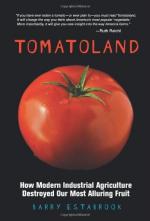|
This section contains 424 words (approx. 2 pages at 300 words per page) |

|
Fruits are ripened ovaries of flowering plants, and are developed from the ovary wall from fertilized ovules (or seeds). The size, shape, color, and other attributes of fruits are extremely variable, depending upon each particular plant species.
Fruits may be dry in texture, such as those of the sunflower Helianthus annua, and the key-like fruits (or samaras) of the sugar maple (Acer saccharum); or they may be thick and fleshy, like the tomato (Lycopersicum esculentum), the apple (Malus pumila), and the watermelon (Citrullus vulgaris).
Some fruits only contain a single seed, as is the case of the avocado (Persea gratissima), the cherry (Prunus avium), the mango (Mangifera indica), and the date palm (Phoenix dactylifera. These single-seeded, fleshy fruits are known as drupes. Other fruits contain numerous seeds, such as the orange (Citrus sinensis), broad bean (Vicia faba), and cucumber (Cucumis sativa). All of these edible, multi-seeded fruits are...
|
This section contains 424 words (approx. 2 pages at 300 words per page) |

|


